Good English food is one of the things I find the hardest to be apart from when I’m travelling. When I last came back to London in January, I spent two weeks practically inhaling my body weight in cheese. And bagels. And bacon, roast dinners, English mustard and the delicious weirdness that is Marmite – because when it comes to food, there’s nothing like home comforts.
So it’s safe to say that, after being back permanently in London for a month, I’m still eating as much as I can get my hands on. And when the guys at Eating London invited me on a tour around the East End of London to spend a day sampling the best food on offer, I wasn’t exactly going to say no.
I’ve always been somewhat fascinated by East London. Nowadays it’s almost ridiculously trendy – filled with independent arty shops, ever-stencilling graffiti artists, and a large number of the braces-and-moustache-wearing hipster crowd – but it also holds an amazing backlog of London history.
If you walk down streets like Artillery Lane and Gun Passage, would you know they’re so named because Henry the Eighth used the area for shooting practice? And have you ever passed a building with a bricked out window and wondered if the phrase ‘daylight robbery’ comes from the window tax, which led people to brick up their windows on order to save money? And there’s nothing like standing outside a multi-storey car park and feeling chills up your spine when you hear that one of Jack the Ripper’s victims was found in this very spot.
London is filled to the brim with stories and secrets – and I couldn’t think of a better way to start delving into them than with someone who actually knew what she was talking about. In this case, it was Emily, a passionate Eating London tour guide who had the joyous task of steering six hungry bodies from eatery to eatery (and occasionally, to a local watering hole).
I’m not a food writer, and I’d never profess to be one. But I am truly interested in the meaning behind food, and the passion involved in making it – and for that reason, I found that the stories entwined in each of our foodie stops on the tour really made the food that we were eating come to life.
So here are a few stories of East End food. Little tasters, if you like.
From snout to tail
For centuries, it was common practice to eat every possible part of a butchered animal. Why waste anything that was edible – particularly during times when food was relatively scarce?
At some point in the last century, though, the ability to freely eat heart, brains and offal has all but disappeared. Nowadays we buy pre-packaged prime cuts of meat in the supermarket, with no real awareness of where it’s come from. So obviously there are a number of chefs and foodies rising up to challenge our current meat mentality – like the minds behind St John Bread and Wine, who serve up delicious variations on ‘snout to tail’ eating.
But we were on the hunt for the infamous St John bacon sandwich – and as we filed into the gleaming white and chrome restaurant on a Thursday morning, it was clear we’d missed the morning bacon sandwich rush. Three figures in chef outfits sat at the table behind us, eating in companionable silence; the rest of the room was empty.
All the better for bacon tasting.
As someone who’s spent the last eighteen months craving the taste of British bacon, there’s a chance I’m biased by saying that the St John bacon sandwich was divine.
They use Gloucester Black Spot pigs, bake their own bread fresh on-site, and even serve little pots of homemade ketchup with a few secret ingredients. We correctly identified one of them as apple, but the rest remain a mystery. I’m ok with that.
A use for stale bread
I settled back against the wooden panels of The English Restaurant, carefully rotating my spoon so the moist bread gave way.
“If you make a dip in the middle you can get more custard in,” Emily said, with a wisdom borne of experience. She wasn’t eating with us, I noticed – although no one else in the pub was eating either. Not bread and butter pudding, anyway. Not at 11 in the morning.
The building which houses The English Restaurant dates back to the 17th century, and was the perfect place to listen to the history of bread and butter pudding – a staple English dessert which I’ve never been too fond of too many bad memories associated with unexpected raisins and sultanas).
Originally cooked up by poor families who didn’t want to waste their leftover stale bread, it was steamed and soaked in milk along with some dried fruit, then baked in the oven. Our taster version was somewhat improved upon – because how are you going to say no to rum custard and a caramelised brioche top?
The passion of a cheesemonger
He came from France, the cheese obsessive, although he’d only worked in the world of cheese for a few years – which I found odd, as I assumed a name as grand as ‘cheesemonger’ would warrant a long, rich, and pungent history of cheese-related employment. Not to be the case.
But his knowledge and excitement was infectious; offering us a succession of wooden boards with small cheese wedges and accompanied by particular fruits and nuts that complimented the flavours. I was more overwhelmed with the sheer smell of the room; like I’d died and gone to cheese heaven.
The Androuet store has been producing cheese in Paris since 1909, but the London branch is run by two French brothers, who mature their cheeses in the basement of the shop. Ie underneath Spitalfields market – which is built on top of an ancient Roman burial site. Interesting…
Streets lined with oyster shells
“Have you got any spare change? I’m just really fucking hungry,” said the girl with bright red sores on her hands and chest, which my eyes were ashamedly drawn to.
I talk to homeless people a lot – always trying to break the barrier, the stereotype of them being ‘different’ – but in these circumstances I didn’t know what to say. This girl knew we were about to eat fish and chips, standing on the street outside a well-known restaurant. She also knew our tour guide, and waved hello when Emily re-emerged from the restaurant with her hands full of newspaper cones.
Poppie’s Fish and Chip Shop is like stepping back into a bygone era of hairnets, rockabilly skirts and constant music playing on the jukebox. The 1940s theme is pretty appropriate, seeing as the shop has been serving customers since 1945 – ever since London was getting back on its feet, post war.
As my fellow foodies were pouring salt and vinegar over their chips, I was more fascinated by Emily’s revelation that, up until well into the Victorian era, this part of London used to be littered with broken oyster shells, because they were a common food of the poor.
It’s bizarre to think how much a city’s food tastes can change over just a few hundred years.
The elusive pub cat, and an authentic British Bangladeshi curry
Although the East End of London is something of a hipster hangout nowadays, there are still a multitude of quiet side streets and hidden alleyways where life seems unchanged – like in Heneage Street, where the Pride of Spitalfields pub remains exactly like it’s always been. Filled with red plush seats and small round wooden tables, the walls are covered in old framed photos of boxers and fruit sellers, and a constant rotation of East End men engaged in conversation, laughing with the barmaids, or sitting alone, nursing a pint.
Pub culture in England is something of great fascination in other countries. When I lived in California, my English friends and I tried desperately to find a ‘normal’ pub, but the Americans weren’t very helpful and the closest thing we could find was an Irish pub – which might sound the same but really isn’t.
Sitting in the Pride with a glass of Somerset Cider, I tried to work out why these places feel so unique. Is it the anonymity? The sense of time standing still? The conspicuous absence of the pub cat? The slight stickiness to the floors that catches at the sole of your shoe?
I was left ruminating on the true essence of an English pub as we walked around the corner, onto bustling Brick Lane. It’s usually traditional to drink a beer alongside another of England’s best loved cuisines: curry. But we decided to treat the beer as a starter (ok, one of many that day), and headed to the Aladin curry house for our main course.
Anyone who’s walked along Brick Lane knows of the intense competition between the hundreds of curry houses that litter this street. Every open restaurant door you pass means a different man shouting his own particular offers in an attempt to entice you inside.
The Brick Lane Curry Extravaganza harks back to the 19th century, when many Bangladeshis, who worked as cooks on the East India Company ships, wanted to find familiar food somewhere in the city. Now it’s the best place in the city to go for a curry .
We were treated to shallow metal dishes filled with vegetable bhuna, lamb pathia and chicken madras, plus naan bread and quite a few bottles of water to deal with the spice levels. If I thought I’d raised my heat tolerance after my travels in India a few years ago, I was sadly mistaken…
Salt beef through the window
I’d always thought of bagels as an American thing. Filled with salt beef, a gherkin on the side (or a pickle, probably, if I’m trying to be accurate) – but in Brick Lane, bagels are unashamedly Jewish. And the bagels – or ‘beigels’ – at Beigel Bake have been traditionally baked for more than 50 years at this Jewish-owned shop; harking back to the era when Brick Lane was mainly inhabited by Jewish families.
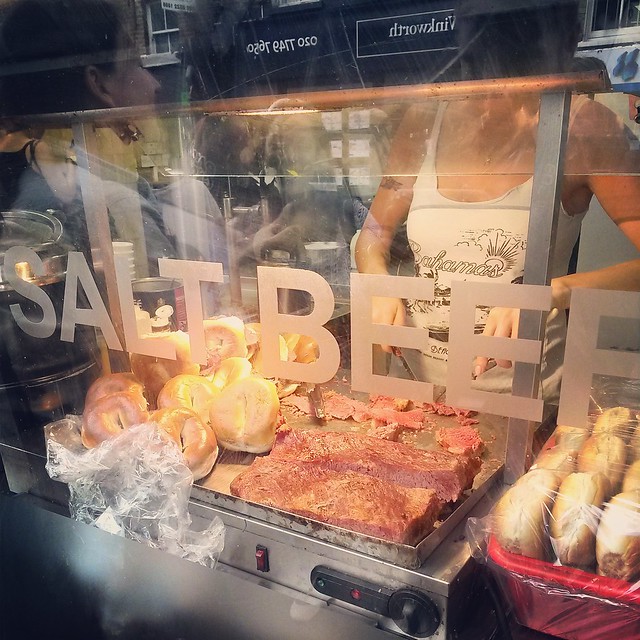
It’s probably for the best that the window was separating me and the bagels/beef/ability to eat all the bagels and beef.
One of the best parts about Beigel Bake is it’s open 24 hours. If you haven’t wandered up and down Brick Lane at three in the morning, desperately trying to work out where the ‘bagel area’ of the endless road is hiding, then you haven’t lived.
Similarly, eating salt beef so tender that it breaks apart before it even touches your teeth (and then a little bit falls onto the pavement) is a moment like no other.
Salted caramel deliciousness
“Can you not take any photos in here, please? Not of the décor, at least…”
It’s understandable, from an architecture perspective; the long wooden benches with attached seats that swing round and out to accommodate bodies; the low metal lamps swinging above our heads; the exposed brickwork, dark wooden floorboards and open plan kitchen, littered with baskets of vegetables and slabs of cheese in the centre of the room.
The building is a former tea warehouse, and the many floors of the aptly named Tea Building are now used as creative spaces for a number of different companies – but Pizza East, on the ground floor, have clearly decided to keep the industrial atmosphere at the forefront.
By the time we’d reached the restaurant I was so full I could barely able to lift my camera, much less take surreptitious photos of the interior. The salted caramel tart they laid in front of me, however, was a different story.
Filling up on London – and its food.
I’d never really thought of looking at London through a foodie perspective. I also never expected to come home to a new fascination for the historical tidbits that litter my city.
But whenever I’m travelling, local food suddenly becomes a lot more important, and it’s sadly all too easy to forget to do the same when you’re at home, unless someone gives you a push in the right direction.
Especially if it involves British bacon.
Disclaimer: my tour with Eating London was complimentary, but anywhere that offers you dessert before midday gets a thumbs up in my book.

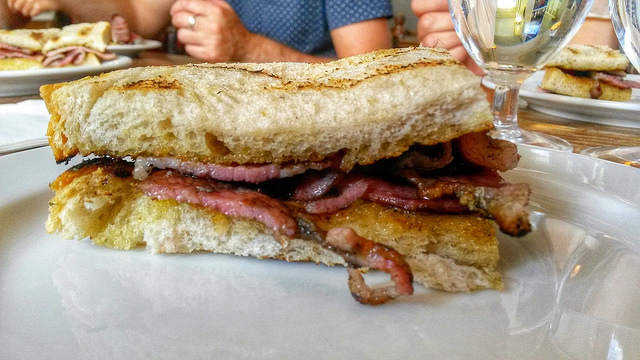
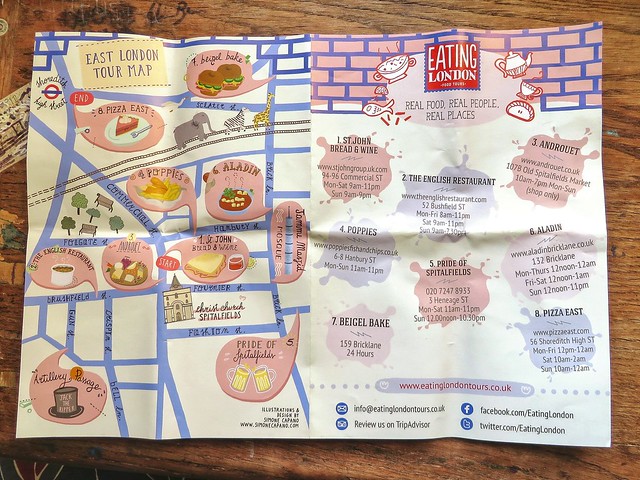
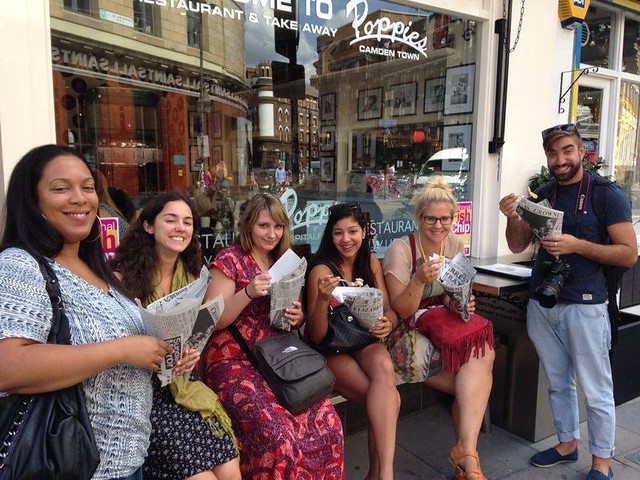
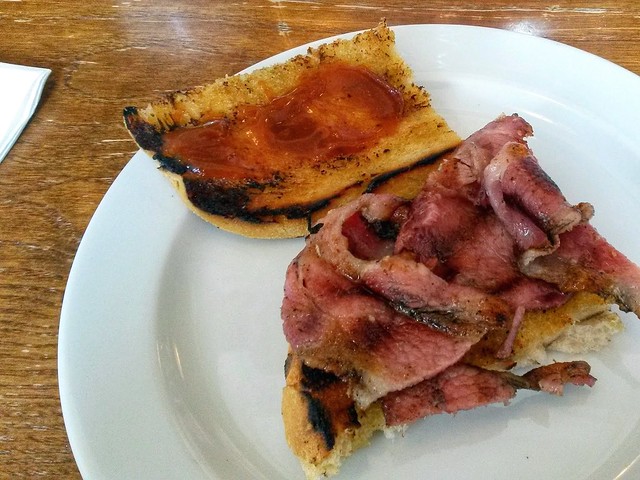
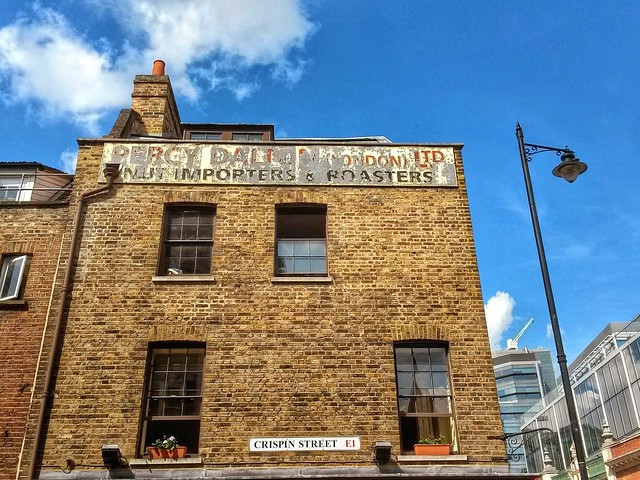
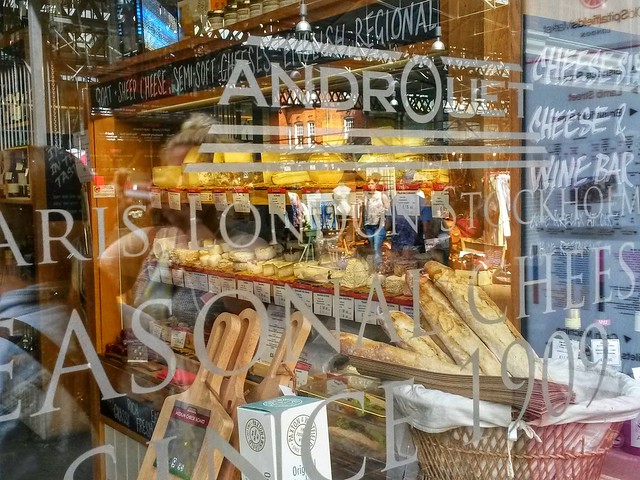
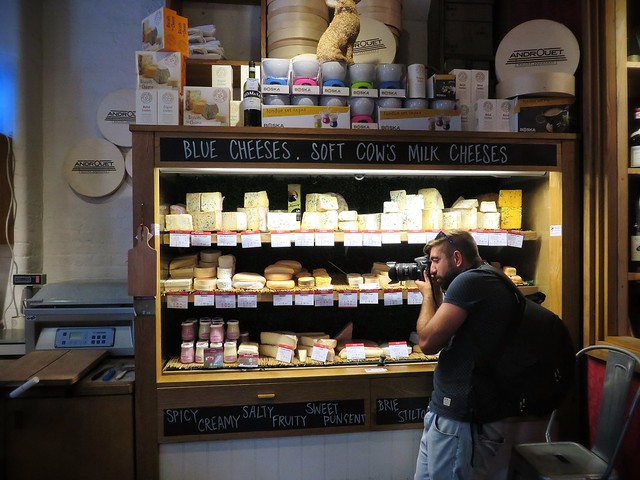
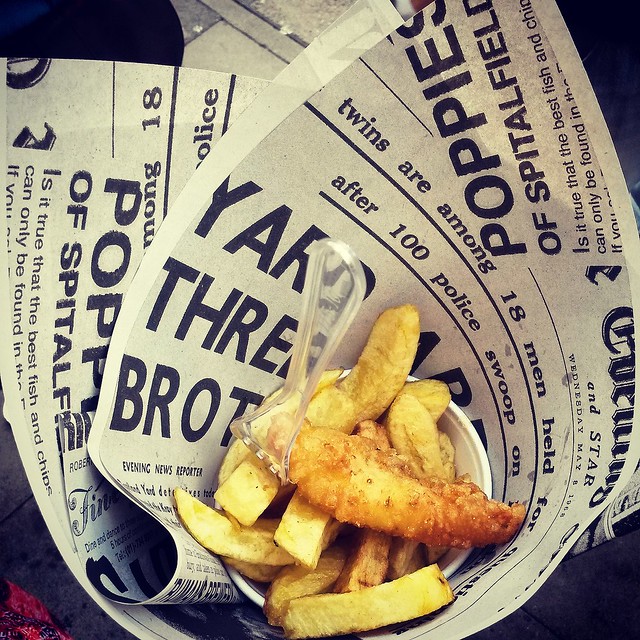

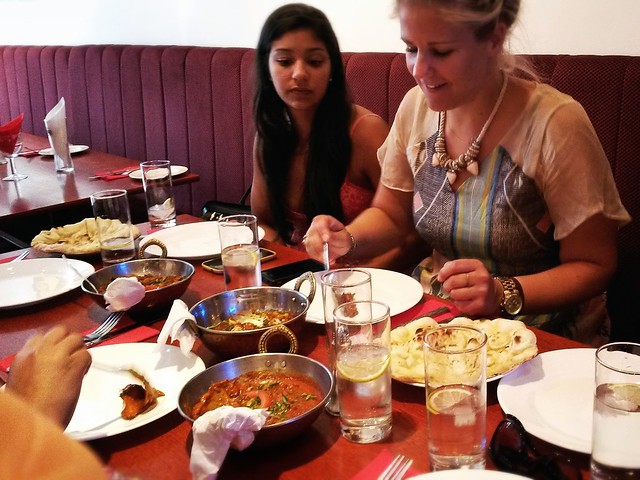
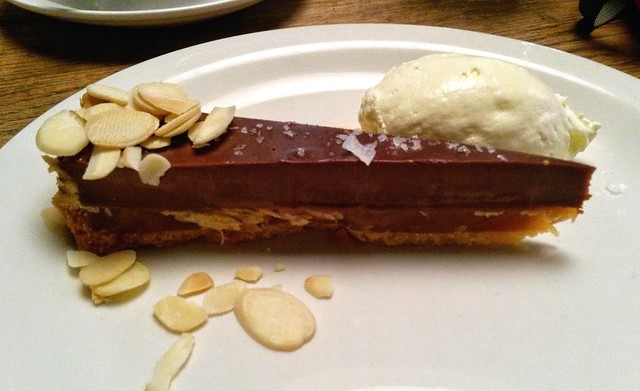



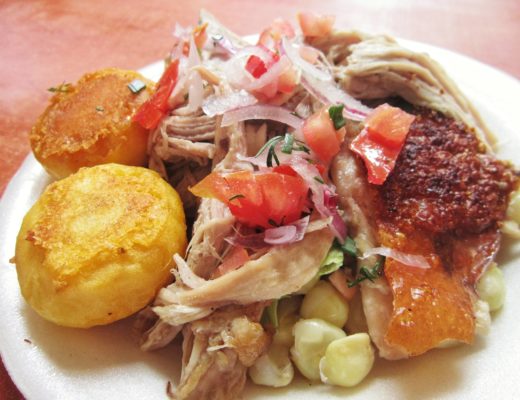
18 Comments
Sharon
September 4, 2014 at 12:35 amGreat tour! Somehow we missed all the places you wrote about but will happily try them next time.
Flora
September 26, 2014 at 12:33 pmI think they’re a little hidden off the beaten track still – which makes them all the more satisfying :p
Andrea Anastasiou
September 4, 2014 at 5:03 amThat salted caramel tart – oh my word! I love food tours and this one looks like it’s a lot of fun.
Flora
September 26, 2014 at 12:33 pmI still dream about that tart..!
Stef
September 4, 2014 at 2:32 pmI have to admit that I also found it hard to enjoy the English cuisine while living there (except for the breakfast). This tour looks like a way to really get to know it and get to love it. Thanks for sharing!
Flora
September 26, 2014 at 12:36 pmOh no, I’m sorry you didn’t enjoy English food that much! I guess you’ve got to know where to go for a better experience – hopefully if you come back you could try some of the places on the tour..!
Katie @ The World on my Necklace
September 8, 2014 at 2:01 amYes, I will definitely be doing this tour next time I am in London! I have done the East End Street Art tour which was great.
Flora
September 26, 2014 at 2:43 pmI really need to get myself on a street art tour one of these days – I’m too obsessed with graffiti not to!
Bali Attractions
September 9, 2014 at 6:31 amUnfortunately East London lacks a public transport system, so getting around is difficult if you don’t have a car
Greg
September 12, 2014 at 1:42 amWhat are you talking about? The worst way to get around would be by car! The area is very walkable, there are buses absolutely everywhere and you also have the Overground.
Nice post Flora, makes me miss home and now I really fancy a bacon sandwich! And some Poppies chips
Flora
September 26, 2014 at 1:50 pmThanks for defending the transport options in East London, Greg 🙂 Every time I come back to this article I want another bacon sandwich.. it’s a problem.
annalisa1988
April 11, 2015 at 5:14 pmWhat are you talking about? I’ve never experienced any problems with public transport in East London!
Lily Lau
September 15, 2014 at 10:52 amFor real you can find all these things in East London? I had no idea! I write you from London indeed and I think this evening I’ll grab a taxi and taste all this things!
Flora
October 18, 2014 at 11:19 amYep, every single place is smack in the middle of East London, Lily 🙂 Let me know how your search goes!
the paper boat sailor
October 8, 2014 at 11:23 amI went to England from India and was warned that the food would be bland and unsatisfactory. At the time I was indeed apprehensive as I was to spend a month travelling around the country, but I was very pleasantly surprised by all the food I ate at lovely local restaurants. In London of course we were completely spoilt for choice, and my stomach is still a little heavy from all the things I gorged on at Portobello Road Market!
Flora
October 18, 2014 at 11:20 amYep, Portobello is a bit of a foodie’s paradise… an extra belt notch or two is usually advised!
Claire
October 9, 2014 at 10:46 pmEast London eats are so amazing! Some little gems can definitely be found! I miss it so much!
Flora
October 18, 2014 at 11:21 amThen clearly you should get back to the area and get eating again!